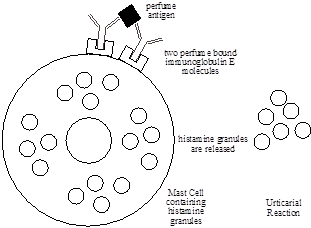Urticaria
HIVES (URTICARIA)
What are the Symptoms?
Acute and Chronic UrticariaHives cause intense itching and stinging. The typical attack of hives lasts no more than several days and often less and is known as acute urticaria. An attack lasting more than 6 weeks is called chronic urticaria. Acute urticaria is usually a type of allergic reaction that occurs, and then resolves within six weeks. More severe symptoms can occur. Hive-like reactions are not always limited to the skin. The same type of inflammation can occur in other parts of the body the windpipe (trachea), voice box (larynx) and air passages (bronchi). When inflammation occurs in these sensitive structures, obstruction to breathing can occur. Some individuals who are allergic to certain foods such as shrimp or lobster can have, in addition to hives, acute difficulty in breathing, which calls for emergency measures similar to those for acute allergic reactions to insect bites.
What Causes Hives? Please read the following carefully and notify Dr. Jacobs if you suspect anything that could be causing your hives. Think about anything you touch or eat. Ask the receptionist for a copy of the ABC Booklet to learn how you can avoid allergies.
Hives can be a reaction to some environmental factor such as an insect bite, a food (shellfish are a notorious cause), a medication, or as one part of the reaction to many different allergens. Pollens in the air and other air borne chemicals and agents can cause hives.
The factors, which cause hives, may be drugs, foods, injected medications (Aspirin, Motrin, Advil), insect stings, physical factors, such as cold, heat, exertion, and light products of infection, digestive disturbances, and emotional factors. Substances used in cigarettes, cosmetics, hand lotions, contraceptives, toothpaste, gargles, and scalp applications are possible causes of hives.
Part of your treatment is to keep a diary of the foods you eat, the personal items you use, and the medicines you take, the time and occasion when you break out, and the duration of your lesions.
Simple hives are commonly associated with the eating of an unusual food such as a dish of strawberries, or a delicious deviled crab. Hives come almost each time such foods are eaten, particularly if alcoholic beverages are consumed with the meal. Other foods to be suspected include eggs, chocolate, nuts, fresh pork, cheese (except cottage cheese), tomatoes, navy beans, cabbage, onions, mushrooms, grapes, pineapple, fresh berries, fresh fruits, oranges, grapefruit, lemons, ginger, pepper, tea, coffee, mint, spices, menthol. It is obviously impossible to eliminate all such foods under ordinary circumstances. Thus, we make the suggestions with the understanding that if you can associate the eating of any of these foods with the hives, this may be important.
Penicillin, Aspirin, and sedatives are the most common medications, which cause hives. However, most other medications can also cause hives including laxatives, eye drops, vitamins, etc.
Infections such as dental abscesses, tonsillitis, sinusitis, cystitis, cholecystitis, and ringworm, can cause hives. Viral infections are second only to drugs as a cause of hives in children. The infections may be mild or may even be overlooked.
Emotional stress and strain are very frequent causes of hives. In most patients the emotional problems are very well concealed, and it is only with great difficulty that a patient can relate emotional causes to his or her skin problem.
Chronic UrticariaPatients with a personal or family history of asthma, hay fever or migraine headache seem to be susceptible to stubborn, chronic hives. Once the cause is identified, the best advice is to avoid subsequent exposure to it if possible. Please understand that the cause of chronic urticaria is not identifiable in as many as 70 to 85 percent of cases. Known inciting causes of chronic urticaria include drugs and, less frequently, foods, inhalants, like pollen, and infestation with parasitic worms. Stress and anxiety are often thought to be important factors.
Hives Can Be A Sensitive Skin SymptomHives are itchy raised welts or plaques that may play a sensitive skin role as part of increased immune reactivity and immunoglobulin E (IgE) action in sensitive skin. This role can be substantial in certain sensitive skin people. Hives, also called urticaria, appear as red, itchy, swollen areas of the skin that can vary in size and can show-up anywhere on the body. About 20% of people will have hives at least once in their lifetime. Acute hives are often due to a viral infection, perfume, drug, food, latex, or other allergen. Some have chronic hives that occur daily for months to years. Constant scratching, direct pressure, or long-term anxiety may aggravate chronic hives. Atopic patients can experience acute hives due to their increased Ig E levels. However, the incidence of chronic hives is not increased in atopic patients. So, sensitive skin people can experience hives but hives do not necessarily mean that the patient has atopic dermatitis. Hives can occur separately from atopic dermatitis and separately from any other form of eczema. Though they are both symptoms of sensitive skin, you should think of hives and eczema as two different entities as hives have a different mechanism than eczema.
You can diagnose hives with a simple skin test. Take a blunt point such as a Chinese chopstick. Using the chopstick, draw an “X” on your bare back. Wait a minute. If you see a red elevated “X” on your back, you have “dermatographism” which is a sign of hives.
|
 |
|
|
 |
 |
|||||||||||
 |
|||||||||||||
    
Home | Dry/Sensitive Skin | Skin Renewal | Skin Complexion & Acne | Dermatology Patient Education |





